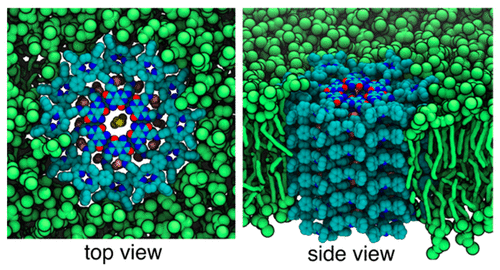当前位置:
X-MOL 学术
›
J. Am. Chem. Soc.
›
论文详情
Our official English website, www.x-mol.net, welcomes your feedback! (Note: you will need to create a separate account there.)
Rosette Nanotube Porins as Ion Selective Transporters and Single-Molecule Sensors
Journal of the American Chemical Society ( IF 15.0 ) Pub Date : 2020-01-08 , DOI: 10.1021/jacs.9b10993 Prabhat Tripathi 1 , Liang Shuai 2 , Himanshu Joshi 3 , Hirohito Yamazaki 1 , William H Fowle 4 , Aleksei Aksimentiev 3, 5 , Hicham Fenniri 2, 6, 7 , Meni Wanunu 1, 6, 7
Journal of the American Chemical Society ( IF 15.0 ) Pub Date : 2020-01-08 , DOI: 10.1021/jacs.9b10993 Prabhat Tripathi 1 , Liang Shuai 2 , Himanshu Joshi 3 , Hirohito Yamazaki 1 , William H Fowle 4 , Aleksei Aksimentiev 3, 5 , Hicham Fenniri 2, 6, 7 , Meni Wanunu 1, 6, 7
Affiliation

|
Rosette nanotubes (RNTs) are a class of materials formed by molecular self-assembly of a fused guanine-cytosine base (G-C base). An important feature of these self-assembled nanotubes is their precise atomic structure, intriguing for rational design and optimization as synthetic transmembrane porins. Here, we present experimental observations of ion transport across 1.1 nm inner diameter RNT porins (RNTPs) of various lengths in the range of 5 - 200 nm. In a typical experiment, custom lipophilic RNTPs were first inserted into lipid vesicles; the vesicles then spontaneously fused with a planar lipid bilayer, which produced stepwise increases of ion current across the bilayer. Our measurements in 1M KCl solution indicate ion transport rates of ~50 ions s-1V-1 m, which for short channels amounts to conductance values of ~1 nS, commensurate with naturally occurring toxin channels such as α-hemolysin. Measurements of interaction times of α-cyclodextrin with RNTPs reveals two distinct unbinding timescales, which suggest that interactions of either face of α-cyclodextrin with the RNTP face are differentiable, backed with all-atom molecular dynamics simulations. Our results highlight the potential of RNTPs as self-assembled non-proteinaceous single-molecule sensors and selective nanofilters with tunable functionality through chemistry.
中文翻译:

玫瑰花纳米管孔蛋白作为离子选择性转运蛋白和单分子传感器
Rosette 纳米管 (RNT) 是一类由融合鸟嘌呤-胞嘧啶碱基(GC 碱基)分子自组装形成的材料。这些自组装纳米管的一个重要特征是它们精确的原子结构,作为合成跨膜孔蛋白的合理设计和优化很有趣。在这里,我们展示了对 5-200 nm 范围内各种长度的 1.1 nm 内径 RNT 孔蛋白 (RNTPs) 的离子传输的实验观察。在一个典型的实验中,首先将定制的亲脂性 RNTP 插入脂质囊泡中;然后囊泡与平面脂质双层自发融合,从而产生跨双层的离子电流逐步增加。我们在 1M KCl 溶液中的测量表明,离子传输速率约为 50 个离子 s-1V-1 m,对于短通道而言,其电导值约为 1 nS,与天然存在的毒素通道如α-溶血素相称。α-环糊精与 RNTP 相互作用时间的测量揭示了两个不同的解结合时间尺度,这表明 α-环糊精的任一面与 RNTP 面的相互作用是可微的,并得到全原子分子动力学模拟的支持。我们的结果突出了 RNTP 作为自组装非蛋白质单分子传感器和具有可通过化学调节功能的选择性纳米过滤器的潜力。
更新日期:2020-01-08
中文翻译:

玫瑰花纳米管孔蛋白作为离子选择性转运蛋白和单分子传感器
Rosette 纳米管 (RNT) 是一类由融合鸟嘌呤-胞嘧啶碱基(GC 碱基)分子自组装形成的材料。这些自组装纳米管的一个重要特征是它们精确的原子结构,作为合成跨膜孔蛋白的合理设计和优化很有趣。在这里,我们展示了对 5-200 nm 范围内各种长度的 1.1 nm 内径 RNT 孔蛋白 (RNTPs) 的离子传输的实验观察。在一个典型的实验中,首先将定制的亲脂性 RNTP 插入脂质囊泡中;然后囊泡与平面脂质双层自发融合,从而产生跨双层的离子电流逐步增加。我们在 1M KCl 溶液中的测量表明,离子传输速率约为 50 个离子 s-1V-1 m,对于短通道而言,其电导值约为 1 nS,与天然存在的毒素通道如α-溶血素相称。α-环糊精与 RNTP 相互作用时间的测量揭示了两个不同的解结合时间尺度,这表明 α-环糊精的任一面与 RNTP 面的相互作用是可微的,并得到全原子分子动力学模拟的支持。我们的结果突出了 RNTP 作为自组装非蛋白质单分子传感器和具有可通过化学调节功能的选择性纳米过滤器的潜力。



























 京公网安备 11010802027423号
京公网安备 11010802027423号